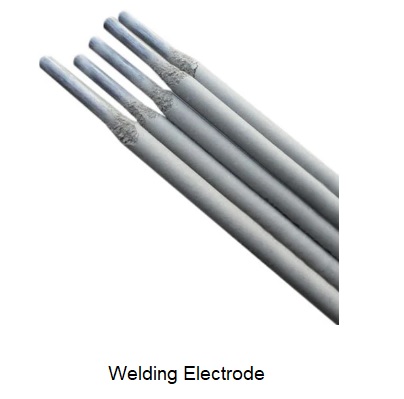What is Electrodes? – Definition, Types, Applications and Advantages
An electrode is a piece of wire or rod (of a metal or alloy), with or without flux covering, which carries current for welding. At one end it is gripped in a holder and an arc is set up at the other end. Electrodes are made of materials having high electrical conductivity as well as thermal conductivity so that heat developed at junction faces between electrodes and work is minimum in the first instance and secondly, whatever heat is produced is conducted away efficiently.
In addition to high electrical and thermal conductivity, electrode material should be of very high mechanical strength so that the wear and tear at the electrode tip is minimum.
The materials used for electrodes are : Hard drawn copper (softening temperature 150°C and for welding of aluminium alloys); Cadmium copper (softening temperature 250°C and for joining MS sheets); Chromium copper (softening temperature 500°C and for joining of steel) and Tungsten copper (softening temperature 1,000°C and for welding of steel) and copper alloys.
The diameter of the electrode is approximately given by the expression d = 5√t
Where
- d is the diameter of tip in mm and
- t the thickness of sheet in mm.
Either non-consumable or consumable electrodes may be employed in arc welding.
Non-consumable electrodes may be of carbon, graphite or tungsten which do not consume during the welding operation. Consumable electrodes may be made of various metals depending upon their purpose and the chemical composition of the metals to be welded.
Types of Electrodes:
In general, the electrodes can be divided into three categories depending upon outer aspects as well as their technological properties.
Bare electrode are most commonly used in automatic and semi-automatic welding. In using the plain or bare electrodes, as the globules of the metal pass from the electrode to the work, they (globules) are exposed to the oxygen and nitrogen in the surrounding air. This causes the formation of some non-metallic constituents which are trapped in the rapidly solidifying weld metal and thereby reduces the strength and ductility of the metal.
Lightly coated (or washed) electrodes have a coating layer several tenths of a millimetre thick. This coating usually consists of lime mixed with soluble glass which serves as a binder. The primary purpose of the light coating is to increase the arc stability, so they are also called the stabilising coatings. No attempt is made to prevent oxidation and no slag is formed on the weld, nor are the mechanical properties of the weld metal improved. For this reason lightly coated electrodes may only be used for welding non-essential jobs.
Heavy coated electrodes, sometimes referred to as shielded arc electrodes, are used to obtain a weld metal of high quality, comparable with, and even superior to, the parent metal in terms of mechanical properties. Heavy coatings employed are composed of ionising (chalk), deoxidising (aluminium, ferromanganese etc.), gas generating (starch), slag forming (kaolin), alloying and binding materials.
Advantages:
These electrodes have the following distinct advantages
- The physical and metallurgical properties of the weld can be influenced by adding alloying components to the covering.
- Basic salts of silicon, magnesium and calcium in the covering form slag which floats on the surface of metal and prevents rapid cooling of the weld. Thus weld does not become brittle.
- The weld metal is protected from oxidising action of atmospheric oxygen and nitrifying action of nitrogen of air due to gases formed from the covering material.
- In case of ac supply arc cools at zero current and there is a tendency of deionizing the arc path. Covering gases keep the arc space ionized.
- During welding the covering extends beyond the core This directs the arc and concentrates the arc stream, reduces thermal losses and causes increase in temperature of electrode tip.
There may also be powder-cored electrodes which have a good portion of the source of metal for depositing in the joint located as powdered iron mixed in with the flux coating. This makes the electrodes much larger on the outside for the same diameter core wire as standard flux coated electrodes. These electrodes are well suited to down-hand welding and are said to deposite more metal in a given period time than standard flux covered electrodes.
Both bare and coated electrodes, for manual arc welding, are made in the shape of rods up to 12 mm in diameter and 450 mm long. Semi—automatic and automatic welding use electrode wire in coils.
